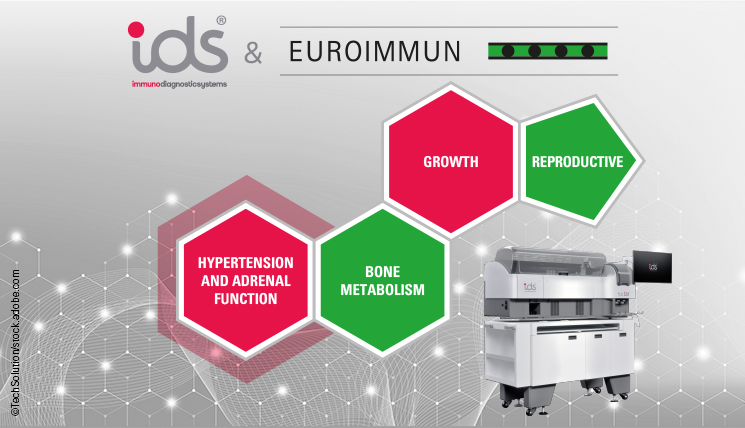Abnormally elevated blood pressure (hypertension, HT) is a major cause of premature death and a challenge worldwide, with an estimated number of >1 billion adults aged 30–79 years having hypertension, many of them unaware of being affected. Unfortunately, HT can be a symptom of various diseases with very different causes, making diagnostics difficult. The adrenal glands, for example, might be at the origin of HT. They sit on top of the kidneys and are involved in a multitude of hormonally controlled processes in the body, e.g. by producing steroid hormones such as cortisol and aldosterone and stress hormones such as adrenaline. The hormonal imbalances due to adrenal gland dysfunctions like Cushing’s syndrome and adrenal insufficiency do not only cause HT, but are also associated with several comorbidities and increased health risks. How can such endocrine causes be tracked down? The answer is: with the help of high-quality diagnostic assays.
Assays for primary aldosteronism (PA)
Approximately 1.4 billion adults worldwide suffer from hypertension (blood pressure >140/90). In 5˗10%, it is caused by primary aldosteronism (PA), the most frequent form of endocrine hypertension – due to either an aldosterone-producing adenoma or to adrenal hyperplasia. In addition to aldosterone excess, a low plasma renin level is characteristic for PA. Renin is a proteolytic enzyme and catalyses the first step of the reactions leading to angiotensin II, which is a vasoconstrictor and major stimulator of aldosterone release. High blood pressure inhibits renin secretion from the kidneys.
For PA screening, it is recommended to first determine the plasma aldosterone-to-renin ratio (ARR), according to the Endocrine Society guidelines. A positive result should be followed by confirmatory or exclusion testing. Precautions such as correct timing and body posture for blood sampling are essential for correct ARR evaluation. In clinical routine, the analytical performance of the assays used is especially critical, with IDS Aldosterone and IDS Direct Renin providing:
• Reliable results in combination with fast and fully automated processing
• Traceability to international standard reference preparations and gold-standard calibration
• Clinical application with validated cut-offs for the ARR in peer-reviewed publications1-4
• No toxic or radioactive waste
Assays for Cushing’s syndrome and adrenal insufficiency
Hypertension is also one of the most common symptoms in Cushing’s syndrome. However, in this case, the high blood pressure is caused by hypersecretion of the steroid hormone cortisol, either due to a dysfunction of the adrenal glands, which produce cortisol, or in response to an elevated level of adrenocorticotropic hormone (ACTH). This peptide hormone is released from the pituitary gland following a diurnal rhythm and under stressful conditions.
In contrast, adrenal insufficiency (e.g. Addison’s disease) results in hypocortisolism, i.e. a too low cortisol level. Accordingly, symptoms include hypotension, fatigue and weakness, possibly culminating in cardiovascular collapse.
When Cushing’s syndrome or adrenal insufficiency is suspected, the determination of cortisol and ACTH levels is an essential diagnostic tool, according to the Endocrine Society guidelines. EUROIMMUN and IDS offer the following comprehensive panel of assays:
• IDS Cortisol
• IDS Salivary Cortisol
• IDS Urinary Cortisol
• IDS ACTH II
The relevant hormones can be measured in a single plasma sample tube. Additionally, saliva or urine can be used as samples for cortisol determination. Each assay delivers precise results over the clinically relevant range, thus supporting the work of endocrinologists and diagnostic laboratories in the best way possible.
Curious? Discover our endocrinology panels and parameters and learn more about endocrinologic diagnostics!
References:
1 Manolopoulou J, Fischer E, Dietz A, et al. Clinical validation for the aldosterone-to-renin ratio and aldosterone suppression testing using simultaneous fully automated chemiluminescence immunoassays. J Hypertens. 33(12):2500-2511 (2015).
2 Genovesi S, Antolini L, Orlando A, et al. Aldosterone-to-renin ratio depends on age and sex in children attending a clinic for cardiovascular risk assessment. J Hypertens. 36(2):344-352 (2018).
3 O’Shea PM, Griffin TP, Browne GA, et al. Screening for primary aldosteronism using the newly developed IDS-iSYS® automated assay system. Pract Lab Med. 7:6-14 (2016).
4 O’Shea P, Brady JJ, Gallagher N, Dennedy MC, Fitzgibbon M. Establishment of reference intervals for aldosterone and renin in a Caucasian population using the newly developed Immunodiagnostic Systems specialty immunoassay automated system. Ann Clin Biochem. 53(Pt 3):390-398 (2016).
